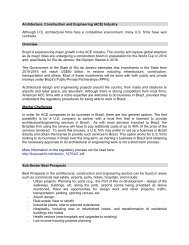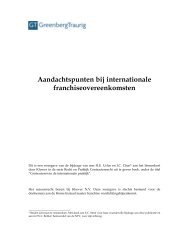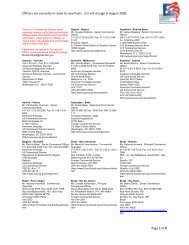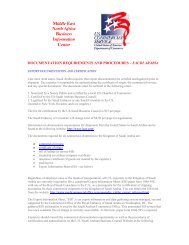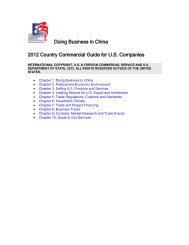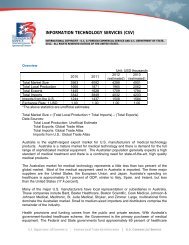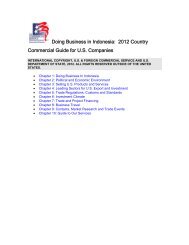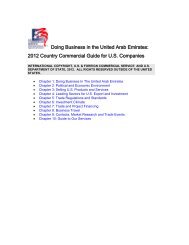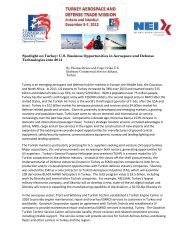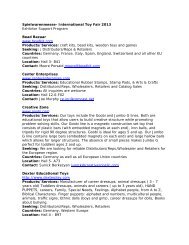Healthcare Technologies Resource Guide - Export.gov
Healthcare Technologies Resource Guide - Export.gov
Healthcare Technologies Resource Guide - Export.gov
You also want an ePaper? Increase the reach of your titles
YUMPU automatically turns print PDFs into web optimized ePapers that Google loves.
Market Entry<br />
U.S. firms should plan their market entry very carefully. Given its location in the center of Europe and<br />
the size of its market, small enough to allow a quick overview, Austria stands out as a desirable, affluent<br />
pilot market for advanced U.S. products. The best strategy is to screen potential distributors and select<br />
a qualified local distributor. Austrian distributors are usually knowledgeable and experienced. They<br />
regularly call on hospitals, clinics, laboratories, and medical doctors with practices. The majority of<br />
distributors are fluent in English. They are also knowledgeable about EU approval procedures and will<br />
obtain approval for U.S. suppliers if needed.<br />
The successful U.S. supplier should discuss and agree on a marketing strategy with a prospective<br />
distributor. Once the agent or distributor is selected, it is preferable to maintain this relationship for a<br />
number of years. Abrupt changes in distribution patterns distract users from trusted suppliers and have<br />
been detrimental to U.S. suppliers who have taken such action in the past. It may take up to two years to<br />
introduce a new product due to the conservative and complex nature of the Austrian market.<br />
The metric system of weights and measures is standard in Austria. The electric power supply is 230/400<br />
volt, AC 50, 1 or 3 phases.<br />
Current Market Trends<br />
U.S.-made products that are on the cutting-edge will have great potential, as Austrians expect hospitals<br />
to have the latest technology. The trend, however, is to reduce the number of hospital beds and to<br />
close down some hospitals altogether. Therefore, American companies that are interested in hospital<br />
construction or in the sale of “routine” hospital equipment and supplies may find their prospects reduced<br />
over the next few years.<br />
Projected growth rates for different imaging products vary considerably. The Austrian market for medical<br />
equipment is constantly evolving and utilizing increasingly sophisticated products.<br />
Scanning units have benefited from technological improvements since their introduction about 30 years<br />
ago. Most suppliers now offer user-friendly features like image networking, which enable the user to<br />
digitally store and project high-quality images. These products should have very good prospects in the<br />
future.<br />
Austria is an interesting market for echographic units. This ultrasound technique continues to gain<br />
popularity as the industry discovers new applications for it. Recent technological advances have enabled<br />
manufacturers to implement Doppler technology and sophisticated probes within their designs. Sales of<br />
conventional radiology apparatus (traditionally, the most popular type of equipment) have declined over<br />
the last several years. The recent ability to digitalize this out-dated equipment, however, has sparked<br />
new interest in traditional radiology. Interventionism radiology is the most recent development in the<br />
medical imagery field. A combination of radiology and surgery, interventionism radiology has resulted<br />
from advances in vascular radiology, digitalization techniques and catheter performance. It promises to<br />
have a strong future.<br />
There is also an increasing demand for all kinds of in-vitro products in Austria.<br />
Main Competitors<br />
The great majority of medical equipment used in Austria is imported. U.S. manufacturers have seized<br />
a substantial share of the market and are now the second-largest supplier group, following German<br />
companies. German competition enjoys the advantages of geographic proximity, a common language,<br />
and products with the same standards, no exchange rate problems, and duty-free access through<br />
Austria’s membership in the EU.<br />
U.S. Commercial Service <strong>Healthcare</strong> <strong>Technologies</strong> <strong>Resource</strong> <strong>Guide</strong> | 2012–2013<br />
7





